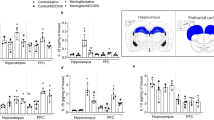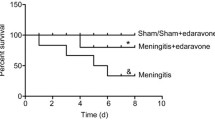Abstract
Bacterial meningitis causes neuronal apoptosis in the hippocampal dentate gyrus, which is associated with learning and memory impairments after cured disease. The execution of the apoptotic program involves pathways that converge on activation of caspase-3, which is required for morphological changes associated with apoptosis. Here, the time course and the role of caspase-3 in neuronal apoptosis was assessed in an infant rat model of pneumococcal meningitis. During clinically asymptotic meningitis (0–12 h after infection), only minor apoptotic damage to the dentate gyrus was observed, while the acute phase (18–24 h) was characterized by a massive increase of apoptotic cells, which peaked at 36 h. In the subacute phase of the disease (36–72 h), the number of apoptotic cells decreased to control levels. Enzymatic caspase-3 activity was significantly increased in hippocampal tissue of infected animals compared to controls at 22 h. The activated enzyme was localized to immature cells of the dentate gyrus, and in vivo activity was evidenced by cleavage of the amyloid-β precursor protein. Intracisternal administration of the caspase-3-specific inhibitor Ac-DEVD-CHO significantly reduced apoptosis in the hippocampal dentate gyrus. In contrast to a study where the decrease of hippocampal apoptosis after administration of a pan-caspase inhibitor was due to downmodulation of the inflammatory response, our data demonstrate that specific inhibition of caspase-3 did not affect inflammation assessed by TNF-α and IL-1β concentrations in the cerebrospinal fluid space. Taken together, the present results identify caspase-3 as a key effector of neuronal apoptosis in pneumococcal meningitis.





Similar content being viewed by others
References
Becker AJ, Gillardon F, Blumcke I, Langendorfer D, Beck H, Wiestler OD (1999) Differential regulation of apoptosis-related genes in resistant and vulnerable subfields of the rat epileptic hippocampus. Brain Res Mol Brain Res 67:172–176
Bifrare Y-D, Täuber MG, Leib SL (2002) Hippocampal apoptosis due to pneumococcal meningitis affects neuronal progenitor cells. Swiss Med Weekly [Suppl 130] 132:9
Braun JS, Novak R, Herzog KH, Bodner SM, Cleveland JL, Tuomanen EI (1999) Neuroprotection by a caspase inhibitor in acute bacterial meningitis. Nat Med 5:298–302
Braun JS, Novak R, Murray PJ, Eischen CM, Susin SA, Kroemer G, Halle A, Weber JR, Tuomanen EI, Cleveland JL (2001) Apoptosis-inducing factor mediates microglial and neuronal apoptosis caused by pneumococcus. J Infect Dis 184:1300–1309
Braun JS, Sublett JE, Freyer D, Mitchell TJ, Cleveland JL, Tuomanen EI, Weber JR (2002) Pneumococcal pneumolysin and H(2)O(2) mediate brain cell apoptosis during meningitis. J Clin Invest 109:19–27
Chen J, Nagayama T, Jin K, Stetler RA, Zhu RL, Graham SH, Simon RP (1998) Induction of caspase-3-like protease may mediate delayed neuronal death in the hippocampus after transient cerebral ischemia. J Neurosci 18:4914–4928
Chen ZL, Strickland S (1997) Neuronal death in the hippocampus is promoted by plasmin-catalyzed degradation of laminin. Cell 91:917–925
Clark RS, Chen J, Watkins SC, Kochanek PM, Chen M, Stetler RA, Loeffert JE, Graham SH (1997) Apoptosis-suppressor gene bcl-2 expression after traumatic brain injury in rats. J Neurosci 17:9172–9182
Clark RS, Kochanek PM, Watkins SC, Chen M, Dixon CE, Seidberg NA, Melick J, Loeffert JE, Nathaniel PD, Jin KL, Graham SH (2000) Caspase-3 mediated neuronal death after traumatic brain injury in rats. J Neurochem 74:740–753
Daigle I, Simon HU (2001) Critical role for caspases 3 and 8 in neutrophil but not eosinophil apoptosis. Int Arch Allergy Immunol 126:147–156
De Bilbao F, Guarin E, Nef P, Vallet P, Giannakopoulos P, Dubois-Dauphin M (1999) Postnatal distribution of cpp32/caspase 3 mRNA in the mouse central nervous system: an in situ hybridization study. J Comp Neurol 409:339–357
Deveraux QL, Takahashi R, Salvesen GS, Reed JC (1997) X-linked IAP is a direct inhibitor of cell-death proteases. Nature 388:300–304
Enari M, Sakahira H, Yokoyama H, Okawa K, Iwamatsu A, Nagata S (1998) A caspase-activated DNase that degrades DNA during apoptosis, and its inhibitor ICAD. Nature 391:43–50
Gavrieli Y, Sherman Y, Ben-Sasson SA (1992) Identification of programmed cell death in situ via specific labeling of nuclear DNA fragmentation. J Cell Biol 119:493–501
Gerber J, Bruck W, Stadelmann C, Bunkowski S, Lassmann H, Nau R (2001) Expression of death-related proteins in dentate granule cells in human bacterial meningitis. Brain Pathol 11:422–431
Gerber J, Raivich G, Wellmer A, Noeske C, Kunst T, Werner A, Bruck W, Nau R (2001) A mouse model of Streptococcus pneumoniae meningitis mimicking several features of human disease. Acta Neuropathol 101:499–508
Gervais FG, Xu D, Robertson GS, Vaillancourt JP, Zhu Y, Huang J, LeBlanc A, Smith D, Rigby M, Shearman MS, Clarke EE, Zheng H, Van Der Ploeg LH, Ruffolo SC, Thornberry NA, Xanthoudakis S, Zamboni RJ, Roy S, Nicholson DW (1999) Involvement of caspases in proteolytic cleavage of Alzheimer's amyloid-beta precursor protein and amyloidogenic A beta peptide formation. Cell 97:395–406
Gillardon F, Bottiger B, Schmitz B, Zimmermann M, Hossmann KA (1997) Activation of CPP-32 protease in hippocampal neurons following ischemia and epilepsy. Brain Res Mol Brain Res 50:16–22
Gould E, McEwen BS (1993) Neuronal birth and death. Curr Opin Neurobiol 3:676–682
Han BH, D'Costa A, Back SA, Parsadanian M, Patel S, Shah AR, Gidday JM, Srinivasan A, Deshmukh M, Holtzman DM (2000) BDNF blocks caspase-3 activation in neonatal hypoxia-ischemia. Neurobiol Dis 7:38–53
Imboden H, Felix D (1995) Immunocytochemistry in brain tissue: methods in neuroscience. Academic Press, New York, pp 236–260
Janicke RU, Sprengart ML, Wati MR, Porter AG (1998) Caspase-3 is required for DNA fragmentation and morphological changes associated with apoptosis. J Biol Chem 273:9357–9360
Kidd VJ (1998) Proteolytic activities that mediate apoptosis. Annu Rev Physiol 60:533–573
Koedel U, Winkler F, Angele B, Fontana A, Flavell RA, Pfister HW (2002) Role of caspase-1 in experimental pneumococcal meningitis: evidence from pharmacologic caspase inhibition and caspase-1-deficient mice. Ann Neurol 51:319–329
Leib SL, Kim YS, Chow LL, Sheldon RA, Täuber MG (1996) Reactive oxygen intermediates contribute to necrotic and apoptotic neuronal injury in an infant rat model of bacterial meningitis due to group B streptococci. J Clin Invest 98:2632–2639
Leib SL, Kim YS, Ferriero DM, Täuber MG (1996) Neuroprotective effect of excitatory amino acid antagonist kynurenic acid in experimental bacterial meningitis. J Infect Dis 173:166–171
Leib SL, Leppert D, Clements J, Täuber MG (2000) Matrix metalloproteinases contribute to brain damage in experimental pneumococcal meningitis. Infect Immun 68:615–620
Leib SL, Clements JM, Lindberg RL, Heimgartner C, Loeffler JM, Pfister LA, Täuber MG, Leppert D (2001) Inhibition of matrix metalloproteinases and tumour necrosis factor alpha converting enzyme as adjuvant therapy in pneumococcal meningitis. Brain 124:1734–1742
Leib SL, Voisin V, Gianinazzi C, Leppert D, De Saizieu A (2001) Gene microarray analysis of differential gene expression in cortex and hippocampus during experimental meningitis. Abstracts of the 41st Interscience Conference on Antimicrobial Agents and Chemotherapy, Chicago, 16–19 December 2001
Lemaire C, Andreau K, Souvannavong V, Adam A (1998) Inhibition of caspase activity induces a switch from apoptosis to necrosis. FEBS Lett 425:266–270
Li Y, Chopp M, Jiang N, Yao F, Zaloga C (1995) Temporal profile of in situ DNA fragmentation after transient middle cerebral artery occlusion in the rat. J Cereb Blood Flow Metab 15:389–397
Liu X, Kim CN, Yang J, Jemmerson R, Wang X (1996) Induction of apoptotic program in cell-free extracts: requirement for dATP and cytochrome c. Cell 86:147–157
Loeffler JM, Ringer R, Hablutzel M, Täuber MG, Leib SL (2001) The free radical scavenger alpha-phenyl-tert-butyl nitrone aggravates hippocampal apoptosis and learning deficits in experimental pneumococcal meningitis. J Infect Dis 183:247–252
Lowry OH, Rosebrough JN, Farr AL, Randall RJ (1951) Protein measurements with the Folin reagent. J Biol Chem 193:265–275
Nau R, Soto A, Bruck W (1999) Apoptosis of neurons in the dentate gyrus in humans suffering from bacterial meningitis. J Neuropathol Exp Neurol 58:265–274
Nicholson DW, Ali A, Thornberry NA, et al. (1995) Identification and inhibition of the ICE/CED-3 protease necessary for mammalian apoptosis Nature 376:37–43
Nitatori T, Sato N, Waguri S, Karasawa Y, Araki H, Shibanai K, Kominami E, Uchiyama Y (1995) Delayed neuronal death in the CA1 pyramidal cell layer of the gerbil hippocampus following transient ischemia is apoptosis. J Neurosci 15:1001–1011
Oppenheim RW (1991) Cell death during development of the nervous system. Annu Rev Neurosci 14:453–501
Pellegrini L, Passer BJ, Tabaton M, Ganjei JK, D'Adamio L (1999) Alternative, non-secretase processing of Alzheimer's beta-amyloid precursor protein during apoptosis by caspase-6 and -8. J Biol Chem 274:21011–21016
Pettmann B, Henderson CE (1998) Neuronal cell death. Neuron 20:633–647
Pfister LA, Tureen JH, Shaw S, Christen S, Ferriero DM, Täuber MG, Leib SL (2000) Endothelin inhibition improves cerebral blood flow and is neuroprotective in pneumococcal meningitis. Ann Neurol 47:329–335
Robertson GS, Crocker SJ, Nicholson DW, Schulz JB (2000) Neuroprotection by the inhibition of apoptosis. Brain Pathol 10:283–292
Salvesen GS, Dixit VM (1997) Caspases: intracellular signaling by proteolysis. Cell 91:443–446
Schluter D, Chahoud S, Lassmann H, Schumann A, Hof H, Deckert-Schluter M (1996) Intracerebral targets and immunomodulation of murine Listeria monocytogenes meningoencephalitis. J Neuropathol Exp Neurol 55:14–24
Schulz JB, Weller M, Moskowitz MA (1999) Caspases as treatment targets in stroke and neurodegenerative diseases. Ann Neurol 45:421–429
Springer JE, Azbill RD, Knapp PE (1999) Activation of the caspase-3 apoptotic cascade in traumatic spinal cord injury. Nat Med 5:943–946
Srinivasan A, Roth KA, Sayers RO, Shindler KS, Wong AM, Fritz LC, Tomaselli KJ (1998) In situ immunodetection of activated caspase-3 in apoptotic neurons in the developing nervous system. Cell Death Differ 5:1004–1016
Thornberry NA, Lazebnik Y (1998) Caspases: enemies within. Science 281:1312–1316
Von Mering M, Wellmer A, Michel U, Bunkowski S, Tlustochowska A, Bruck W, Kuhnt U, Nau R (2001) Transcriptional regulation of caspases in experimental pneumococcal meningitis. Brain Pathol 11:282–295
Wellmer A, Noeske C, Gerber J, Munzel U, Nau R (2000) Spatial memory and learning deficits after experimental pneumococcal meningitis in mice. Neurosci Lett 296:137–140
Wijsman JH, Jonker RR, Keijzer R, Velde CJ van de, Cornelisse CJ, Dierendonck JH van (1993) A new method to detect apoptosis in paraffin sections: in situ end-labeling of fragmented DNA. J Histochem Cytochem 41:7–12
Wyllie AH, Kerr JF, Currie AR (1980) Cell death: the significance of apoptosis. Int Rev Cytol 68:251–306
Yakovlev AG, Knoblach SM, Fan L, Fox GB, Goodnight R, Faden AI (1997) Activation of CPP32-like caspases contributes to neuronal apoptosis and neurological dysfunction after traumatic brain injury. J Neurosci 17:7415–7424
Acknowledgements
We greatly acknowledge Dr. D. Nicholson (Merck Frosst Canada & Co.; ΔC-APP antibody), and Dr. A. Srinivasan (Idun Pharmaceuticals; CM 1 antibody) for supporting this work. We thank Franziska Simon, Andreas Messerli and Oliver Schütz for excellent technical support. This work was supported by grants from the Swiss National Science Foundation (32-61654.00 and 632-66057.01), the Meningitis Research Foundation (14/00), and the NIH (NS-35902).
Author information
Authors and Affiliations
Corresponding author
Rights and permissions
About this article
Cite this article
Gianinazzi, C., Grandgirard, D., Imboden, H. et al. Caspase-3 mediates hippocampal apoptosis in pneumococcal meningitis. Acta Neuropathol 105, 499–507 (2003). https://doi.org/10.1007/s00401-003-0672-7
Received:
Revised:
Accepted:
Published:
Issue Date:
DOI: https://doi.org/10.1007/s00401-003-0672-7




